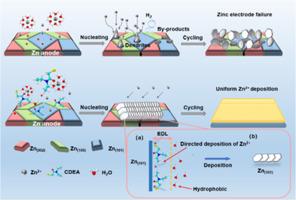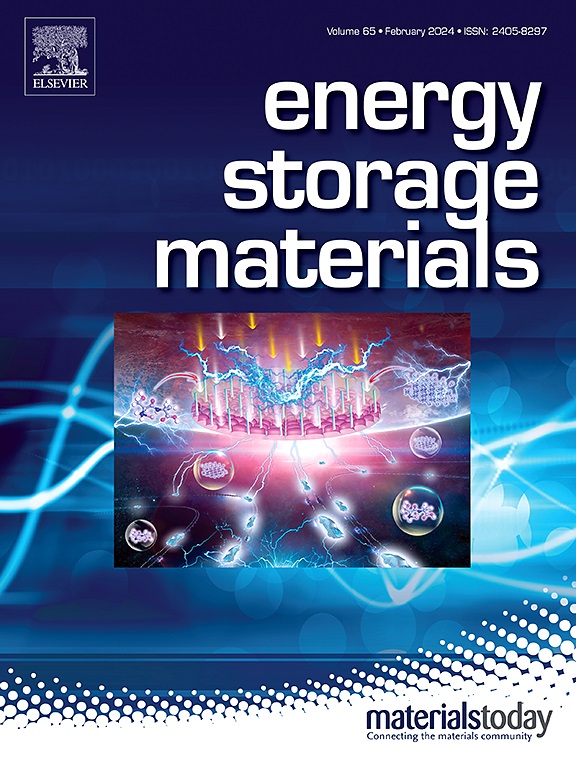Guiding the crystal orientation to coordinate zinc deposition for high-durable zinc-ion batteries
IF 20.2
1区 材料科学
Q1 CHEMISTRY, PHYSICAL
引用次数: 0
Abstract
The Zn(002) texture deposition with high thermodynamic stability is considered to be an efficient approach for mitigating dendrite growth and side reactions. However, attaining (002) plane-oriented Zn deposition is difficult because of significant lattice deformation and non-uniform electric field distribution. Herein, an electrolyte containing N, N-diethylchloroacetamide (CDEA) is proposed to regulate the epitaxial deposition of Zn2+. The CDEA molecule exhibits the preferential adsorption on Zn(101) via the polar -C = O group in CDEA, thereby promoting the predominant exposure of the Zn2+ plane with the lowest deposition rate on Zn(101), which in turn facilitates uniform Zn deposition along the Zn(101) orientation. Consequently, the asymmetrical Zn//Cu cell has exceptional cycling stability, exceeding 1700 cycles with an average coulombic efficiency (CE) of up to 99.72 %. Moreover, the Zn//VO2 full cell can stably maintain a high specific capacity of 245.5 mAh g −1 even after 4000 cycles. The current work sheds new light on how to generate dendrite-free Zn anodes using crystal plane manipulation techniques.


高耐久锌离子电池晶体定向协调锌沉积研究
具有较高热力学稳定性的Zn(002)织构沉积被认为是抑制枝晶生长和副反应的有效方法。然而,由于显著的晶格变形和不均匀的电场分布,实现(002)平面取向Zn沉积是困难的。本文提出了一种含有N, N-二乙基氯乙酰胺(CDEA)的电解质来调节Zn2+的外延沉积。CDEA分子通过CDEA中的极性-C=O基团在Zn(101)上表现出优先吸附,从而促进Zn(101)上沉积速率最低的Zn2+平面的优势暴露,从而促进Zn沿Zn(101)取向均匀沉积。因此,非对称锌/铜电池具有优异的循环稳定性,超过1700次循环,平均库仑效率(CE)高达99.72%。此外,在4000次循环后,Zn//VO2电池可以稳定地保持245.5 mAh g−1的高比容量。目前的工作为如何使用晶体平面操纵技术生成无枝晶锌阳极提供了新的思路。
本文章由计算机程序翻译,如有差异,请以英文原文为准。
求助全文
约1分钟内获得全文
求助全文
来源期刊

Energy Storage Materials
Materials Science-General Materials Science
CiteScore
33.00
自引率
5.90%
发文量
652
审稿时长
27 days
期刊介绍:
Energy Storage Materials is a global interdisciplinary journal dedicated to sharing scientific and technological advancements in materials and devices for advanced energy storage and related energy conversion, such as in metal-O2 batteries. The journal features comprehensive research articles, including full papers and short communications, as well as authoritative feature articles and reviews by leading experts in the field.
Energy Storage Materials covers a wide range of topics, including the synthesis, fabrication, structure, properties, performance, and technological applications of energy storage materials. Additionally, the journal explores strategies, policies, and developments in the field of energy storage materials and devices for sustainable energy.
Published papers are selected based on their scientific and technological significance, their ability to provide valuable new knowledge, and their relevance to the international research community.
 求助内容:
求助内容: 应助结果提醒方式:
应助结果提醒方式:


